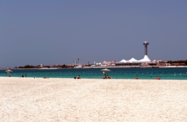Although the two biggest tourism events of the year have yet to take place, Abu Dhabi’s hospitality sector is registering strong growth and making solid headway on meeting its annual growth target.
“Year-on-year (y-o-y) we are two-thirds of the way to achieving our annual target of a 10% increase in hotel guests to 1.65m,” said Mubarak Al Muhairi, the director-general of Abu Dhabi Tourism Authority. “This is without the pull of our headline attraction, Ferrari World Abu Dhabi, which will open in October, or our flagship event, the Formula One Grand Prix, which takes place in November.”
In August, hotels and hotel apartments in the emirate achieved a 6% rise in guests compared to the same month in 2009. A total of 122,475 visitors stayed in properties throughout the emirate during this period. This was achieved thanks to a 10% increase in the number of room nights compared to August 2009. Furthermore, a 4% bump in the average length of stay, which rose to 2.92 nights, also acted as a welcome fillip to the industry.
The first eight months of 2010 saw 1.2m guests, up 15% over the same period last year. Meanwhile, the amount of room nights booked with Abu Dhabi’s hoteliers up until the end of August amounted to 3.2m, a rise of 13% on 2009.
In 2009, Abu Dhabi’s hotels hosted more than 1.5m guests. Much of this growth was attributed to the substantial number of UAE residents who decided to holiday at home. Domestic travel within the UAE, which accounted for 42% of hotel guests, increased by 26% over 2008.
Over the years Abu Dhabi has succeeded in attracting more visitors from international markets as well. The most foreign tourists arrived from Britain (96,709), the US (67,804), India (61,241), Germany (59,667), Egypt (43,304), France (34,776), Saudi Arabia (30,717) and Italy (29,653). The UK has continued to be Abu Dhabi’s leading international market in 2010, with 75,565 British nationals arriving in the first eight months of the year, an 18% increase over the same period in 2009.
Closer to home, the GCC is proving a reliable source of visitors as well. Some 686,981 nationals from the region stayed in Abu Dhabi’s hotels in the first eight months of 2010 – a 20% rise over the same period in 2009. Saudi Arabia led the regional market in terms of visitors to the emirate, with figures showing a 23% y-o-y increase.
Although more travellers are visiting, occupancy rates are actually dropping, with a rise in room inventory over the last 18 months the main reason for this. According to ADTA, occupancy levels slipped to 51% in August 2010, a 21% decrease. This, in turn, impacted average room rates, which fell by 24% y-o-y. The upside of this, however, is that local hotels are now offering a better value proposition to visitors.
“We are now a competitive destination. After having previously been criticised by the trade and meetings planners for being too expensive, a more realistic balance is now being sought between the needs of investors and those of the consumer,” Al Muhairi said.
Bringing international events and attractions to the emirate, such as the Formula One Grand Prix and Ferrari World Abu Dhabi, is an important plank in boosting occupancy rates. Hotels are already experiencing strong bookings for the race period and the addition of Ferrari World, which will be the world’s biggest indoor theme park, is expected to help attract more leisure tourists throughout the rest of the year. Located on Yas Island, the theme park will include the world’s fastest rollercoaster, as well as an array of other high-tech motorsport-related attractions.
Experts are optimistic that Abu Dhabi's tourism sector will end the year on a high. Tourism-related businesses are looking forward to a flood of motorcar aficionados from all over the world. F1 fans – known for being well heeled – will pump cash into hotels and restaurants, buoying the local hospitality industry. Moreover, the Grand Prix will help to promote the capital internationally and should encourage more people to visit the Abu Dhabi in the future.

